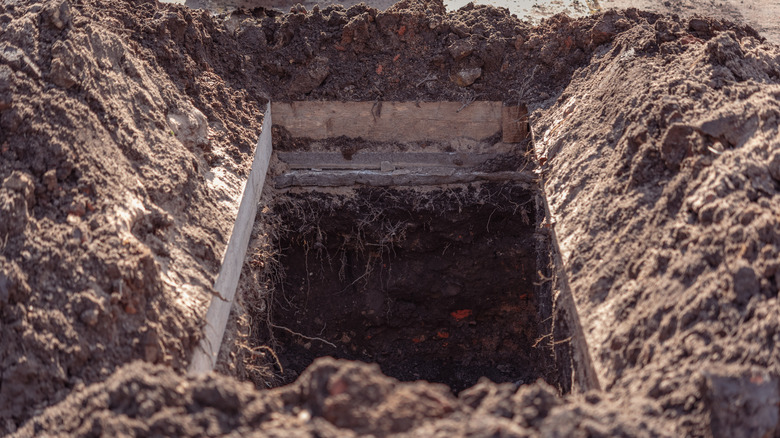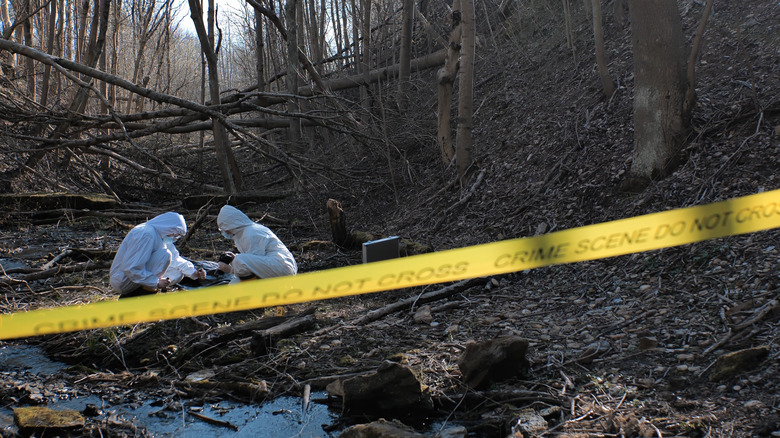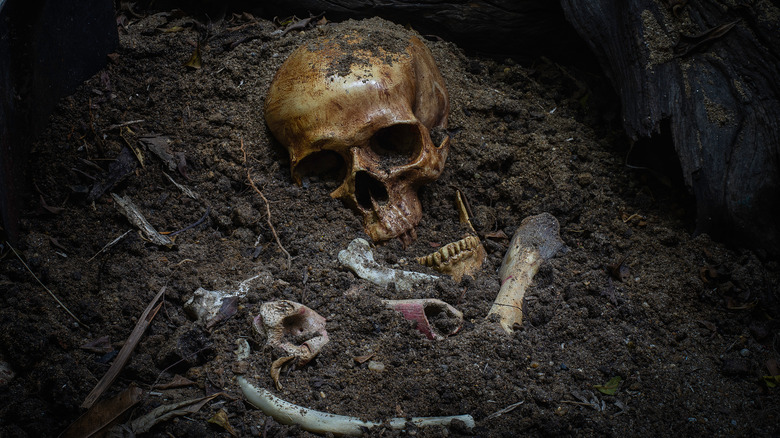What Really Happens To Your Body After 10 Years In A Coffin
Despite all depictions of violence in the media, death is something often kept out of sight in the modern world. As the opening for Karl Ove Knausgaard's Proust-like, 3,600-page epic "My Struggle" depicts (per Culture Trip), people pass away and are passed along. They're covered in sheets and kept out of sight until morticians beautify them for their final public reveal. Then the casket is closed, and that enclosure is literally stuffed into the ground and left impossible to access. (At least in the U.S., not in Buddhist or Hindu-majority countries that favor cremation.)
This hands-off attitude toward death and the dead has left folks curious about what happens to the body after death. Does the body putrefy into a mass of watery substances or desiccate like a pharaoh? What about mausoleums? Or types of coffin wood? Or a steel vault? Or methods of embalming? Do overall health and age factors of the deceased matter? Could you transform into a "bog person" like Tollund Man in Denmark if only you sunk into a peat bog at the moment of death (as Atlas Obscura depicts)? Could your body absorb some crazy fungus and become an honest-to-goodness member of the legion of the undead in a zombie apocalypse (per The Atlantic)?
The short answer is: It depends. There are lot of factors that contribute to the state of a body after 10 years in a coffin. Certain biological facts, though, let us create a glass window in the lid of a casket.
Tagged, bagged, and processed
As biohazard removal specialist Aftermath explains, every human body undergoes the same stages of decay within a coffin or otherwise, barring exceptions like mummification (which involves removing the organs) and environmental factors (wet vs. cold environment, for example). In general, the body at one month vs. one year vs. 10 years is actually not too, too drastic. Most dramatic decay happens within the first month after death.
Non-cremated bodies pass through the same sets of hands within the "funeral service industry," as Ranker explains, which includes morticians, undertakers, and funeral arrangers. First, the recently deceased are passed along to autopsy techs, who may or may not extract all of a person's organs. After this, a sutured body is passed along to an embalmer, who undoes the stitches, replaces the organs, and injects a mixture of embalming fluid called "cavity fluid" into various vessels. A sealant is placed over the sutures to "prevent leakage" and sometimes plastic and powder are placed over the body as well. This is all before the mortician applies makeup, trims nails, and dresses the dead for burial.
During this entire time, the body undergoes decay that influences what it looks like 10 years down the line. Within three days after death, in fact, the body undergoes autolysis — self-digestion — when bodily enzymes eat their own cells. Blood pools in parts of the body closest to the ground. Rigor mortis occurs and skin gets loose. And the abdomen? Generally, it turns lime-green.
Decay sets in immediately
Decay beings at the moment of death, when all cellular activity stops. After the first three days of autolysis, the body begins to bloat and exude foul-smelling gases, and releases fluid from the mouth and nose. This might have been the inspiration for ancient vampire myths, as National Geographic explains.
Putrefaction occurs three to five days after death, which explains why wakes are typically held right away — morticians can only do so much. Decay slows down a bit during this phase, but not by much. From eight to 10 days skin recedes from fingernails and toenails, as Ranker describes, which gives nails the impression of being much larger. As decomposition settles in, the tinge of the body shifts from green to a "deep reddish color," or even black, as Vox says. At this point, a body starts to look "much less human." This is when, without coffins, a body in the ground settles into "active decomposition," when tissues turn to liquid and maggots eat through flesh.
Within a few weeks of death, nails and teeth straight up fall out and most flesh is gone. The body stops emitting a foul smell at this point, and by all accounts simply exudes a "mild, cheese-like odor." Besides fleshier areas like the stomach, not much but cartilage, tendons, bones, and hair remain. This stage, "advanced decomposition," is when the body dries out and insects turn their attention to tendons.
One year in the ground
Solid metal caskets and advanced embalming techniques, like injecting formaldehyde into the body, can only slow decomposition so much, as Vox describes. All such measures, like life itself, are absolutely temporary. This is why some folks have taken to embracing the inevitable and using eco-friendly, full-wood caskets that decompose right along with the dead and return to Earth. These kinds of choices have an impact on the speed of decomposition from about one month after death, but not the initial, rapid stages of decomposition described earlier. But no matter what, nothing much "human" remains after about a year.
Drier conditions prolong decomposition over the year after death, and wetter conditions accelerate it. As Insider explains, if an environment is dry enough, someone can even mummify naturally. When water evaporates through skin, especially thin skin on the ears, nose, and eyelids, those patches of skin can turn black. This kind of mummification isn't quite Egyptian pharaoh-level preservation, but it's something. Coffin flies play a role, too. As the Natural History Museum of Los Angeles Country explains, coffin flies (Latin name: Conicera tibialis) burrow right into the ground and into coffins, lay eggs that hatch into maggots that eat corpses, and can pass through several generations before surfacing.
By a little over a year after death, bodily fluids disintegrate cotton clothes. Only nylon seams and waistbands survive. From here on, decomposition slows down ever further.
Shifting around in the grave
While it's certainly disturbing to imagine a corpse shifting around a bit after death, it does happen. As Insider explains, the Australian Facility for Taphonomic Experimental Research (AFTER) tracked the decomposition of buried corpses for 17 months by taking pictures every 30 minutes. They found, bit by bit, the position of corpses and directions of their limbs change over time. Arms pointed down, for instance, tended to shift up and out to the side. Given how many gases and fluids are released from the body after death, and how the body dries and certain areas become taut or loose, it's not too difficult to see how a corpse could contort or move while decaying.
More to the point, this kind of post-death movement can help forensics researchers at crime scenes. Depending on how much time has passed after death — the "post-mortem interval" — a body might not be in the same position as when a person died. It's easy to see how this can have a huge impact on criminal investigations, and help detectives come to better conclusions regarding the circumstances surrounding someone's death.
Future goals include using further analysis of the movement of corpses after death to create a large, blow-by-blow database that investigators can reference during an investigation. After taking the post-mortem interval into account, crime scenes and body positions could compose a more accurate portrait of the moment of death.
Teeth, bones, sinew, and grave wax
Nothing dramatic happens to a corpse on the slow path of decay from one year to 10 years, and then complete decomposition. Sealed metal caskets can help keep out moisture and bacteria. On the other hand, this can also cause caskets to pressurize as decomposing bodies release gas. Wooden caskets can distort in shape, as Trusted Caskets says, and even explode underground. As you can imagine, this definitely won't help preserve a body.
If someone were to open your coffin after a decade they'd find teeth, bones, hair, maybe some skin and sinew, and fibers from whatever clothing hasn't deteriorated. They'd also find some hard, soap-like substance around the area once occupied by your butt and thighs. This substance, rather gruesomely called "grave wax," forms from body fat under the right conditions of moisture and low-oxygen environments.
From there, as Ranker outlines, skeletonization sets in as the body loses the last of its organic matter and bones essentially become fossils. Eventually, as Insider explains, the soft collagen in bones disintegrates and the bones then become hollow and brittle. This entire process from skeleton to dust is called diagenesis, described in detail on These Bones of Mine. In soil, diagenesis can finish as quickly as 20 years, as Crime Clean-up says. Otherwise, it can take up to 100 years or more. At that point, some teeth might still be left behind, along with grave wax and synthetic materials like nylon.





